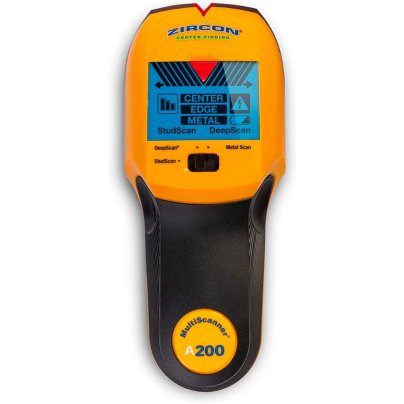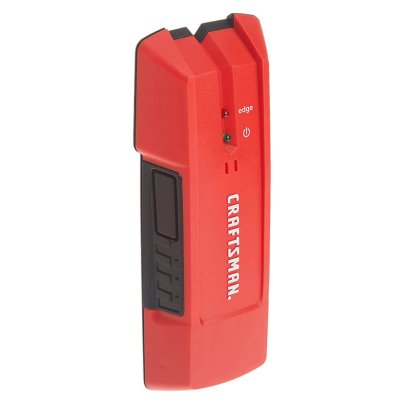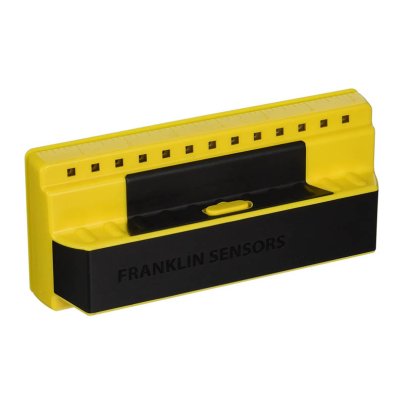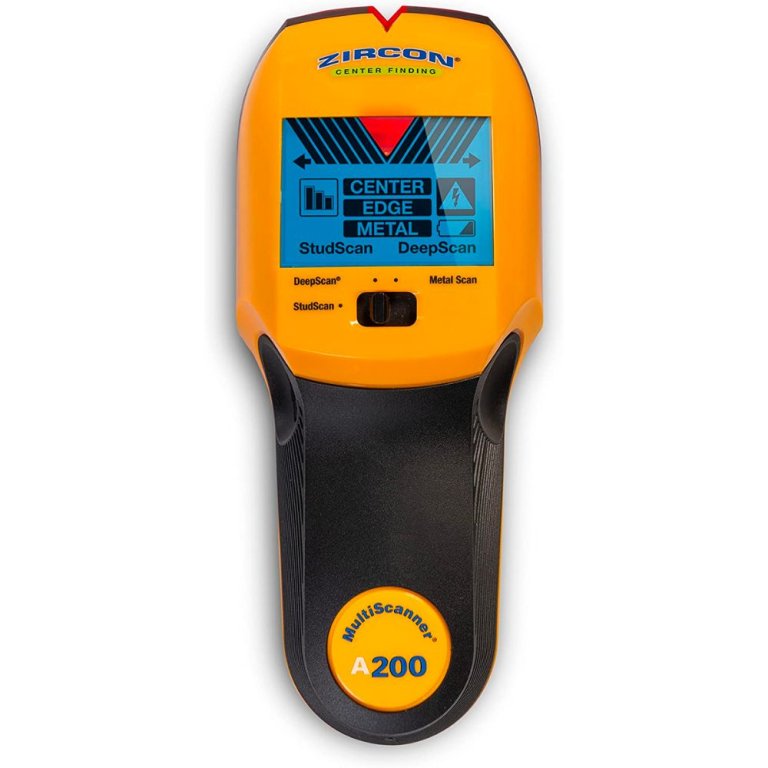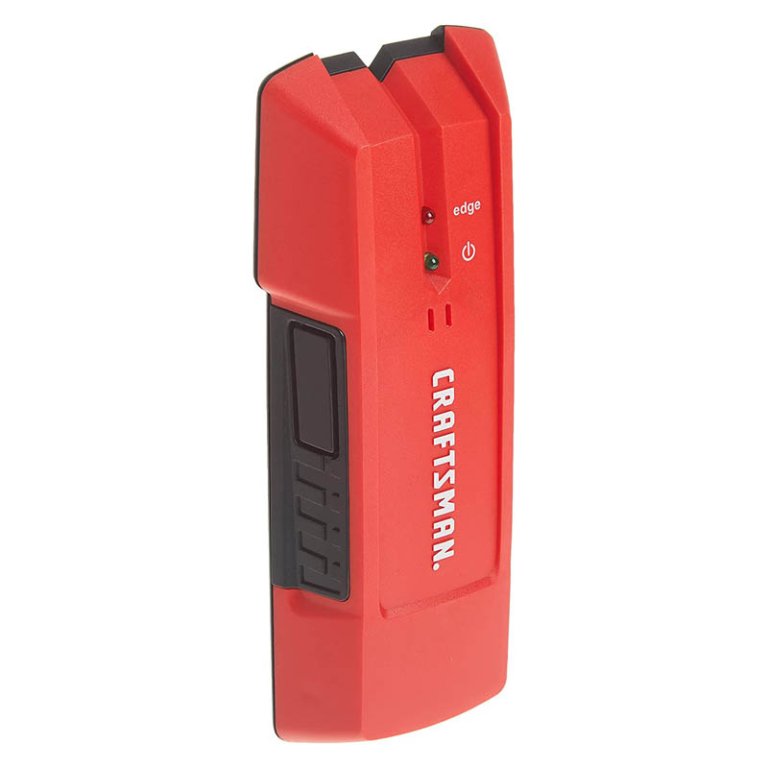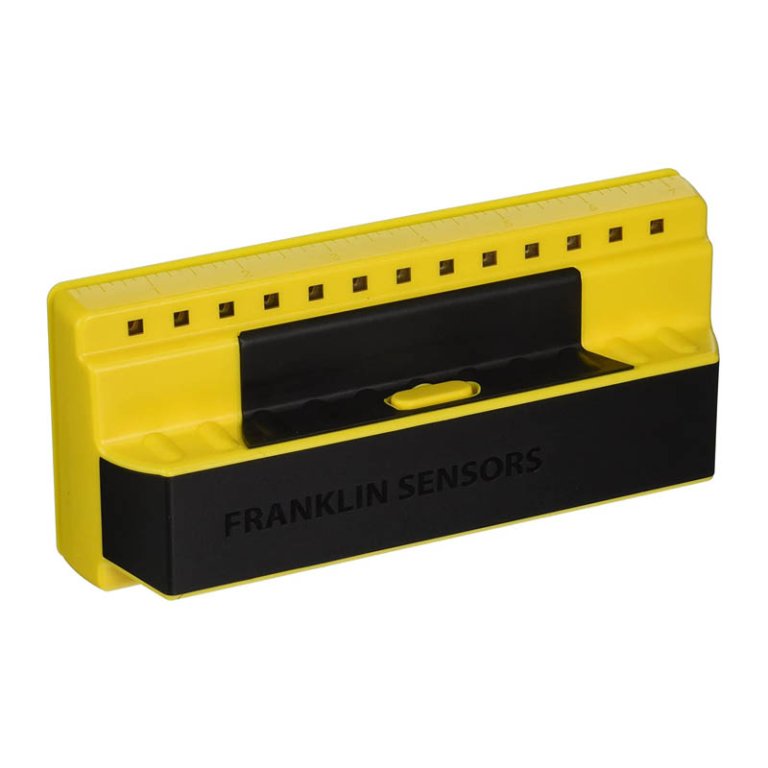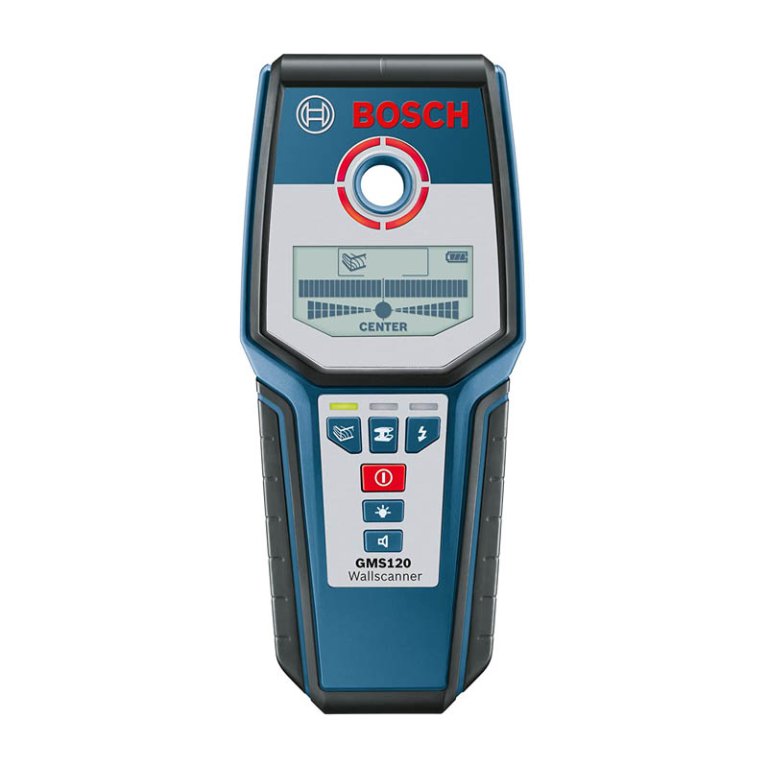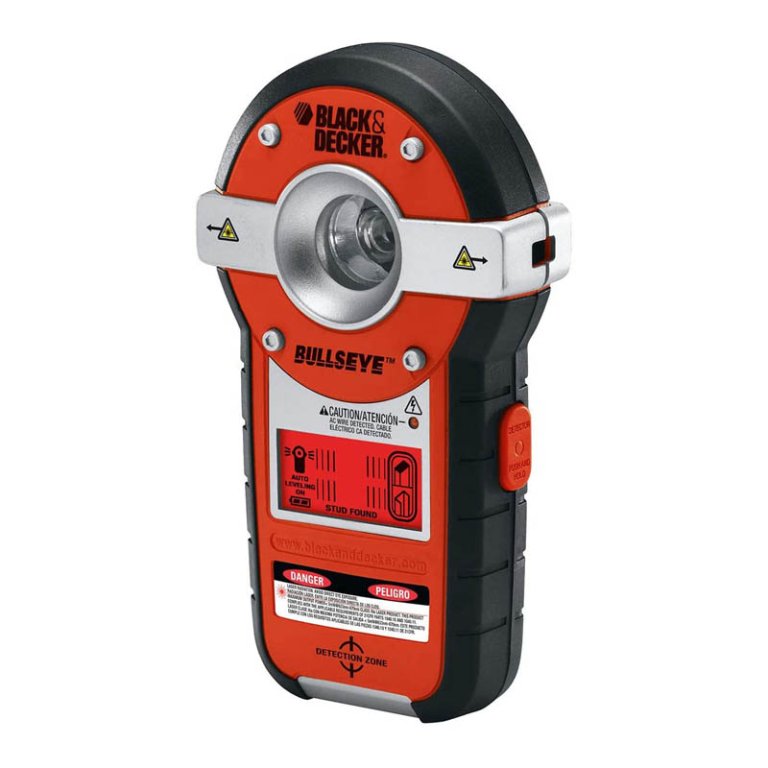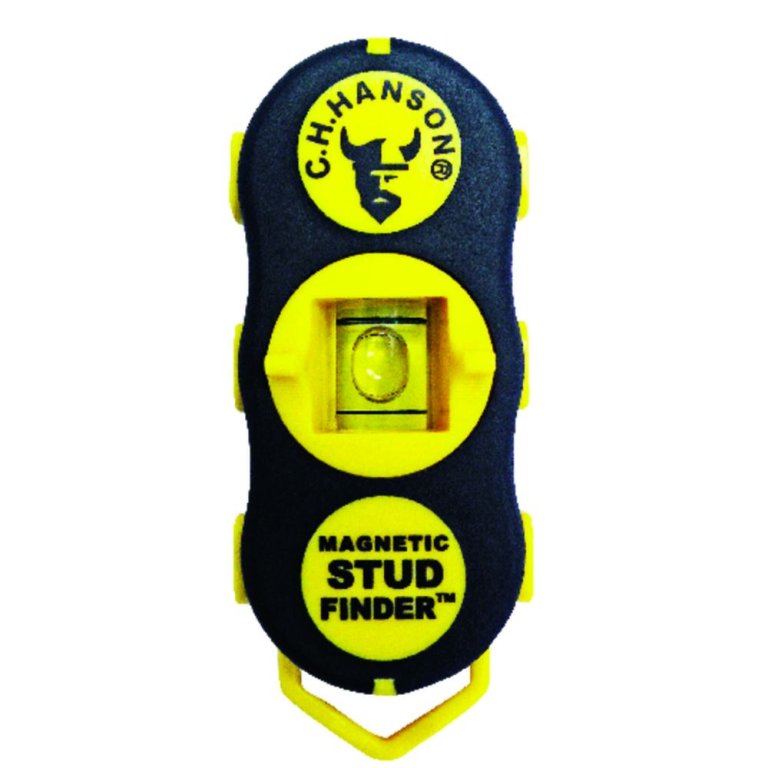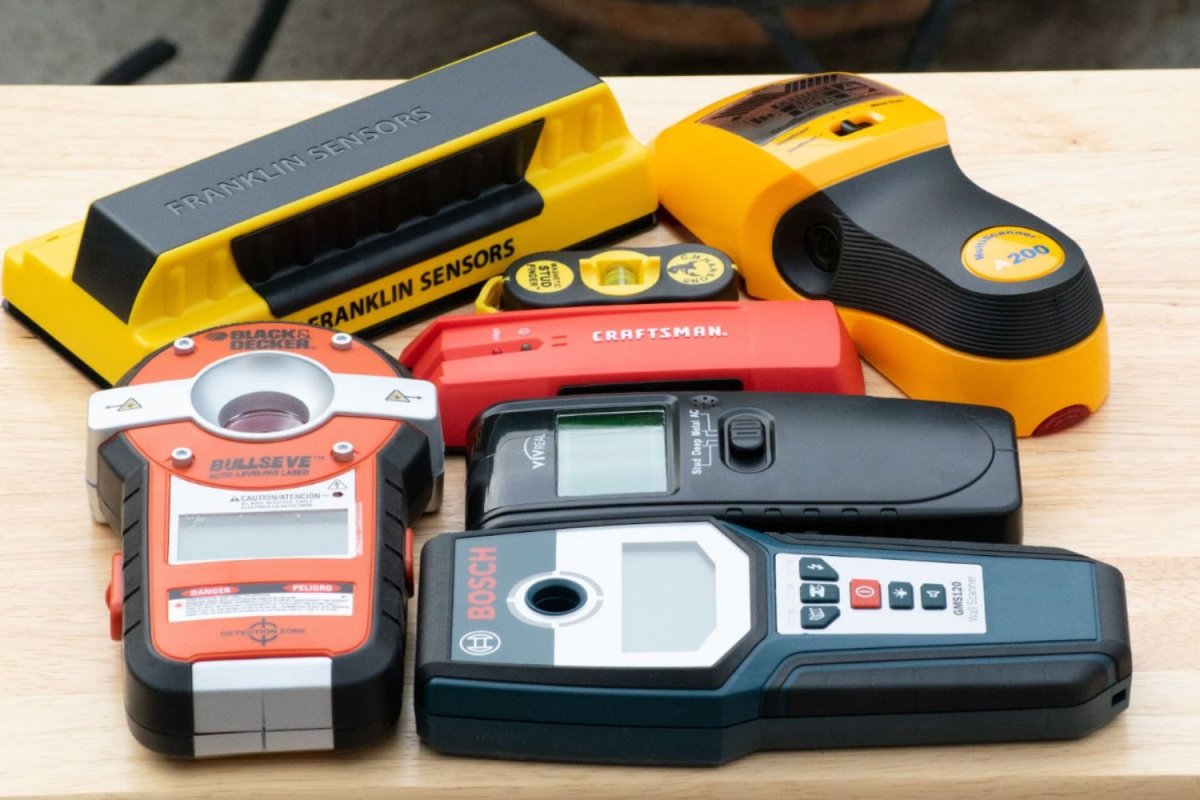
We may earn revenue from the products available on this page and participate in affiliate programs. Learn More ›
If you’ve ever had to install shelving or hang picture frames, you’ve more than likely had to find out where the studs were located behind the drywall. Generally, it’s quicker and more reliable to use a tool specially designed for the purpose: a stud finder. We decided to test a slew of them to help readers find one that suits their needs, including both magnetic and electronic models to find the best stud finder options for a variety of user preferences.
While selecting our list of top picks, we also decided to get professional advice about stud finder features from an expert, John Mazzuca. He is a home builder at Gambrick in Point Pleasant, New Jersey, who has more than 25 years of experience in construction. All his recommendations are included below.
Our favorite is the Zircon MultiScanner A200 Stud Finder. This electronic option comes with center and edge detection, and it works on live wires as well as wood and metal studs. Plus, it has a large, easy-to-read LCD screen.
Read on to learn what to look for in a stud finder and find out which popular models scored highest with our expert and during our tests.
- BEST OVERALL: Zircon MultiScanner A200 Stud Finder
- BEST BANG FOR THE BUCK: Craftsman ¾-Inch-Depth Stud Finder
- BEST FOR PROS: Franklin Sensors ProSensor 710 Stud Finder
- BEST MULTIPURPOSE: Bosch GMS 120 Wall Scanner
- BEST WITH LASER LEVEL: Black+Decker BullsEye Auto Leveling Laser
- BEST MAGNETIC: C.H. Hanson 03040 Magnetic Stud Finder
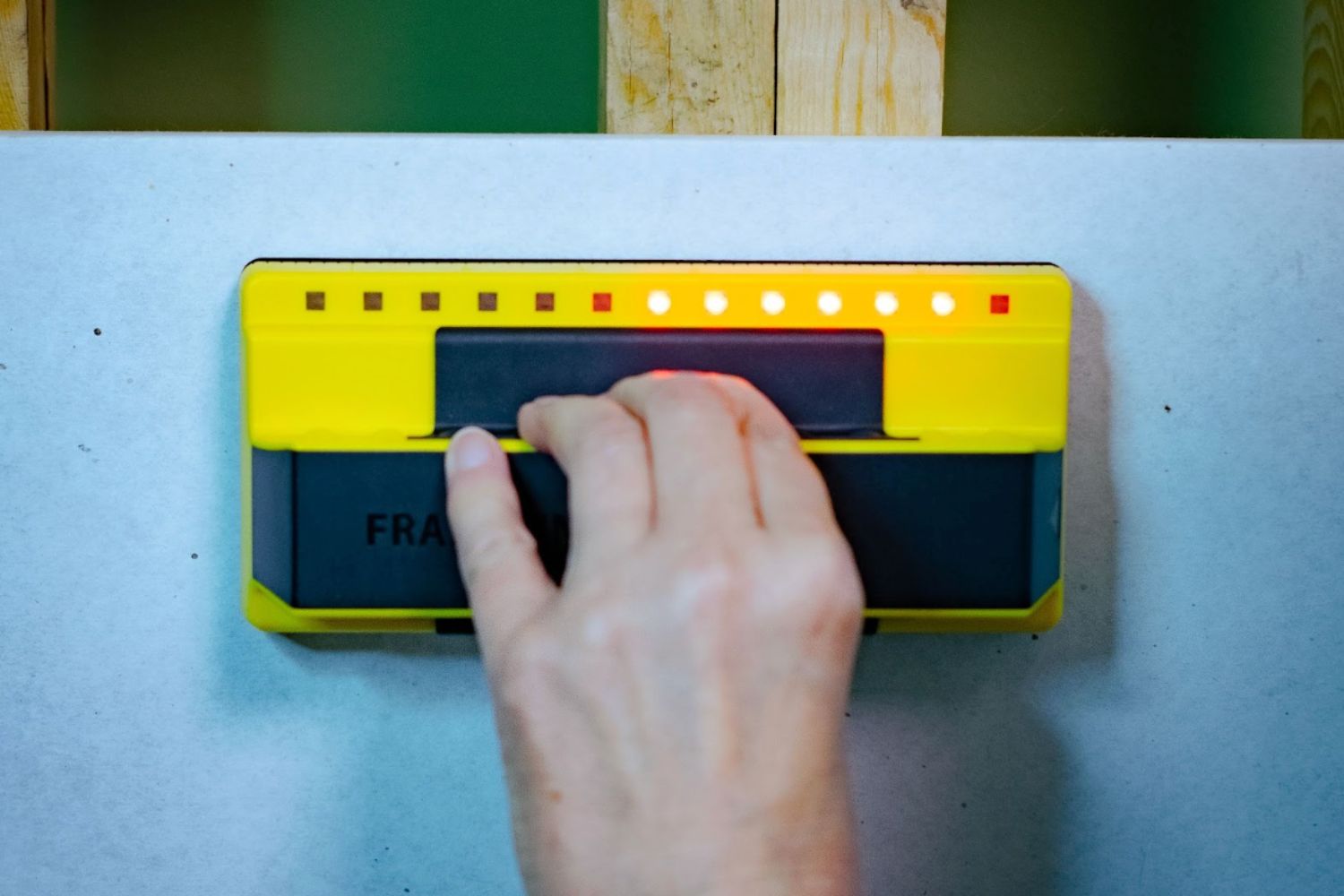
How We Tested the Best Stud Finders
Home builder Mazzuca says that stud finders are great for everyday projects around the house, like mounting a TV, hanging a picture, or installing a cabinet. “But, most people don’t know they can also be used to detect pipes, wiring, and dense objects hidden inside the wall,” he says.
Mazzuca notes this is particularly helpful when working on older buildings as well as homes that have been remodeled several times that “sometimes have objects, masonry, or cast-iron pipes hidden inside the walls.”
Since DIY projects most likely involve fixing up an older building, each one of the tools we tested had to be reliable, accurate, and versatile enough to detect a range of materials behind drywall to make this list of the best stud finders.
I wanted to create a test situation that was very close to the situation DIYers and pros face when trying to find wall studs, so I built a facsimile of a stud wall. I framed up a test board with several vertical studs and attached standard ½-inch drywall to the bottom half of the studs. That allowed me to test the tools on the drywall while noting how accurate they were. In addition, to test for live wires, I ran the stud finders (the ones with wire-finding functions) over a section of wall in my home where I know electrical wires run.
I scored each stud finder on accuracy, ease of use, and screen visibility, and I recorded the scores on a rubric. At the end of the testing, I added up the scores for each stud finder and used them to categorize the tools based on their best use.
Our Top Picks
I was pleasantly surprised to find that the majority of stud finders tested were accurate and dependable. The ones that weren’t didn’t make this list. The following stud finders detect anything from steel studs and fasteners to live wires and pipes. Some even detect double-stud construction. To test the degree of accuracy, I constructed a test wall that mimicked the configuration of an actual wall to see how precise the stud finders were. Find out what the tests revealed and why the following stud finders made it on the list of Top Picks.
Best Overall
Zircon MultiScanner A200 Stud Finder
What We Like
- Versatile option; detects both wood and metal stud types
- Features center and edge detection for added precision while detecting
- Large LCD screen allows users to see measurements easily
- Accurate to within 1/16 inch for precise detection
What We Don’t Like
- Occasional error message appears on the screen
Product Specs
- Type: Electronic
- Center or edge detection: Both
- Modes: Wood studs, metal studs, live wires
This Bob Vila Approved product carries our brand’s highest level of recommendation.

Bob Vila Approved recognizes the household and DIY products that impressed us most in our real-world testing and that exemplify core values of the Bob Vila brand, including craftsmanship, innovation, and value for the dollar. Winners of this designation come recommended by our professional review team and are personally approved by Bob Vila.
Never miss a stud again. For those who need to find the center of a stud, either for securely hanging artwork or cutting the drywall along the stud’s centerline, the Zircon stud finder shines. I inserted a 9-volt battery, and the stud finder was ready to go. As I slid the tool across the surface of the test wall, diagonal lines appeared on either side of the digital display to indicate the sensors were moving over a stud. As soon as I reached the stud’s center, the lines met in a “V,” and a lighted red arrow appeared on the wall above.
The red arrow was right on the center of the stud and had I inserted a nail or screw at that point, it would have been dead-on. I moved on to testing for repeat accuracy on a regular wall. I started at one end of the wall and made an entire scan from side to side. Every time the Zircon tagged the center of a stud, I marked the wall with a pencil. To my amazement, the marks were almost exactly 16 inches apart (within 1/16 inch). This was without needing to calibrate the tool, but the Zircon does come with an auto-calibration feature if it ever needs to be recalibrated for accuracy.
The Zircon stud finder also did an excellent job of detecting live wires, and while I didn’t have any metal studs to scan for, the stud finder detected steel rebar in a concrete planter.
Note: Since we conducted our tests, a newer model Zircon MultiScanner A250c became available. Though I didn’t test it, Zircon appears to have updated the backlit screen to indicate the scanning mode based on the color of the display—blue for metal scanning, green when scanning for wood studs, and red when searching for live wires. This appears to be a smart addition, and I look forward to trying it out in the future.
Get the Zircon stud finder at Amazon.
Best Bang for the Buck
Craftsman ¾-Inch-Depth Stud Finder
What We Like
- Lightweight compared to similar options; suitable for transporting to the jobsite
- Straightforward operation; appropriate for first-time users as well as professionals
- Detects both wood and metal studs for added versatility; suitable for thick studs
What We Don’t Like
- No center detection available; only detects the rough area of stud location
Product Specs
- Type: Electronic
- Center or edge detection: Edge
- Modes: Wood studs, metal studs
This basic Craftsman stud finder doesn’t come with a lot of bells and whistles, but it gets the job done—and at a very attractive price point. I was a bit surprised on the first inspection of the Craftsman stud finder; it weighs less than 4 ounces, and it’s just 5½ inches long. I didn’t hold out much hope that it would do the job. I was wrong.
I put a 9-volt battery in the stud finder and pressed the power button on the side. A beep and a green light on the top lit up to indicate the stud finder was ready to go to work. With this stud finder, I discovered the user has to hold the power button down while scanning—let off the button and the tool goes back to sleep.
I ran the Craftsman stud finder over the test wall and then over a standard wall. When the sensor detected the edge of a stud, the tool emitted a beep, and the “Edge” light on the front lit up. This wall scanner comes with an edge sensor only, but that’s all that’s needed to find a stud. A standard 2-by-4 stud is 1½ inches thick, so by measuring ¾ inch from where the Craftsman indicates the edge of a stud, the user can find the center. For the cost, the accuracy can’t be beat.
Get the Craftsman stud finder at Amazon or Lowe’s.
Best for Pros
Franklin Sensors ProSensor 710 Stud Finder
What We Like
- Simple 1-handed operation provides ample ease of use; suitable for DIYers as well as professionals
- Versatile features; detects entire stud for exact measurements
- Large display can detect double studs for more user-friendliness
What We Don’t Like
- Does not detect live wiring; may require a different detection device
Product Specs
- Type: Electronic
- Center or edge detection: Both
- Modes: Wood studs, metal studs
Nothing could be simpler, or more accurate, than the Franklin Sensors ProSensor stud finder. I already had this stud finder in my tool box, but I wanted to know if its exceptional accuracy extended to the updated models. I wasn’t disappointed. I loaded the Franklin stud finder up with two AA batteries and started testing.
To use the ProSensor stud finder, the user needs to depress the scan button on the side (or on the top, as I typically hold it) and pass the tool over the wall. The nicest thing about the ProSensor is that its scan bed is 7½ inches long, and the finder contains multiple sensors. A series of 13 lights are located along the top of this Franklin stud finder, and as the tool passes over a stud, the corresponding light is illuminated. This allowed me to detect both single-stud and double-stud framing members within the test wall. In addition, a 7½-inch ruler is etched into the top of the stud finder so users can check measurements.
The key to the precision of the ProSensor is the line of LED lights that runs along the tool. With the ProSensor, it’s possible to detect and distinguish between studs located within a few inches of one another, as is often the case near a door or in the corner of a room, making this stud detector well suited for remodeling contractors who need to find the locations of multiple framing configurations.
Read our full review: Franklin Sensors ProSensor 710 Stud Finder
Get the Franklin Sensors stud finder at Amazon.
Best Multipurpose
Bosch GMS 120 Wall Scanner
What We Like
- Audible alerts for hands-free use and ample user-friendliness
- Easy-to-see LCD screen allows for precise detection for professional or DIY use
- Quick calibration for fast and easy detection
- Takes measurements quickly from room to room
What We Don’t Like
- Occasional false reading on live wires; may be tricky to use at times
Product Specs
- Type: Electronic
- Center or edge detection: Center
- Modes: Wood stud, metal stud, live wires
I found the Bosch GMS 120 wall scanner highly accurate for detecting a range of materials, even materials found in thicker walls. Like many electronic stud finders, the Bosch takes a 9-volt battery to run all its functions. It comes with user-friendly images on the front to detect wood, metal, and live wire, making it easy to use the device even without reading the instructions.
One of the features I liked most about the Bosch stud finder is its actual power button. There’s nothing for the user to hold down while scanning. Use the power button to turn the tool on, and it stays on until you turn it off. While this may lead to batteries running down more quickly if the device is inadvertently left on, I liked this feature immensely. With an always-on power button, I could hold the tool the way I wanted to rather than needing to grasp it awkwardly to keep a button depressed.
The Bosch stud finder is self-calibrating. Turn it on, select the mode, and then hold it in place on the wall for a few seconds to calibrate it. During scanning, when the tool neared a stud, an orange light ring on the face lit up. As I slid the device over the stud, the light ring turned red, and the stud finder emitted a beep. When the tool was directly over the stud, the word “Center” appeared on the LCD display.
The Bosch stud finder also hit on live wiring in the wall and on metal fasteners in wood studs. In addition, this multiuse stud finder can turn on a backlight in the display and mute the beeping noise, making it well suited for low-light situations or where someone might find the beeping distracting.
Get the Bosch stud finder at Amazon or The Home Depot.
Best with Laser Level
Black+Decker BullsEye Auto Leveling Laser
What We Like
- Versatile features for multiple tasks; emits side-to-side laser for leveling
- Audible and visible detection alerts for added ease of use
- Easy calibration for quick detection; suitable for professional and DIY use
What We Don’t Like
- Laser can only be used horizontally, not vertically
- Must be adjusted to measure ceiling heights
Product Specs
- Type: Electronic
- Center or edge detection: Edge
- Modes: Wood studs, metal studs, live wires
Say goodbye to crooked picture frames. Unlike other stud finders, the Black+Decker stud finder features an edge-type sensor, and the tool comes with a self-leveling horizontal laser line. Together, the two functions make an impressive team for hanging a series of pictures or other artwork.
It features self-calibration that requires holding the tool against the wall and then depressing the power button and holding it down for a few seconds. The word “Initializing” flashes across the red-backlit LCD screen, quickly followed by the word “Ready.” The tool is then ready to begin scanning.
I tested the Black+Decker on the test wall to determine its accuracy. As I moved the stud finder toward the stud, a series of lines appeared at the outer edges of the screen to indicate the edge of a stud was detected, and the words “Stud found” appeared on the screen. To find the center of the stud, I marked the wall when the finder detected one edge, and then I scanned from the other side and did the same thing. The center was right between the two marks.
Then I tried the laser, and I was sold. Here’s how easy it is to use: In the upper center of the stud finder is a clear plastic depression with a hole in the very middle. I made a mark with a pencil on the wall and then lined up the hole in the stud finder with the pencil mark. I then switched on the laser function from a button on the side—a bright red laser beam shone out horizontally.
I had my helper make a pencil mark about 4 feet away on the laser line. I then inserted two nails in each of the marks and tied a taut string between them. I checked the level of the string with my carpenter’s level, and it was accurate. For those who need to be able to define a horizontal level and detect wood and metal studs, the Black+Decker stud finder does the trick.
Get the Black+Decker stud finder at Amazon.
Best Magnetic
C.H. Hanson 03040 Magnetic Stud Finder
What We Like
- Magnetic operation means there are no batteries required for use
- Small and lightweight enough to carry in a pocket; excellent portability
- Pinpoints nails in wood studs for accuracy and added convenience
What We Don’t Like
- Doesn’t detect studs but rather nails in studs; may require additional stud finder
- May errantly detect other bits of metal in walls; not as accurate as similar options
Product Specs
- Type: Magnetic
- Center or edge detection: Not applicable
- Modes: Nail detection in wood studs
No batteries? No problem. This magnetic stud finder is super portable and designed to detect either metal studs or the metal fasteners in the studs, making it among the best options for those who need to locate studs without worrying about batteries running down.
On the test wall, the C.H. Hanson magnetic stud finder stuck by itself to the drywall when it was placed over the location of a metal fastener. I moved the tiny stud finder around in large swooping circles on a standard wall and eventually felt a magnetic pull; it took maybe 15 to 20 seconds.
The small C.H. Hanson magnetic stud finder is an excellent backup for an electronic stud finder, and if carrying space in a tool box or tool belt is at a premium, it won’t take up a lot of room. While some magnetic stud finders feature only one magnet, this one includes two, one at each end. The CH Hanson also includes a built-in bubble level, which makes the next step—mounting something on the wall—that much easier. When the user is done with it, they can slip the compact 3-inch-long tool in a pocket or stash it in a kitchen junk drawer until it’s needed again.
Get the C.H. Hanson magnetic stud finder at Ace Hardware or The Home Depot.
Jump to Our Top Picks
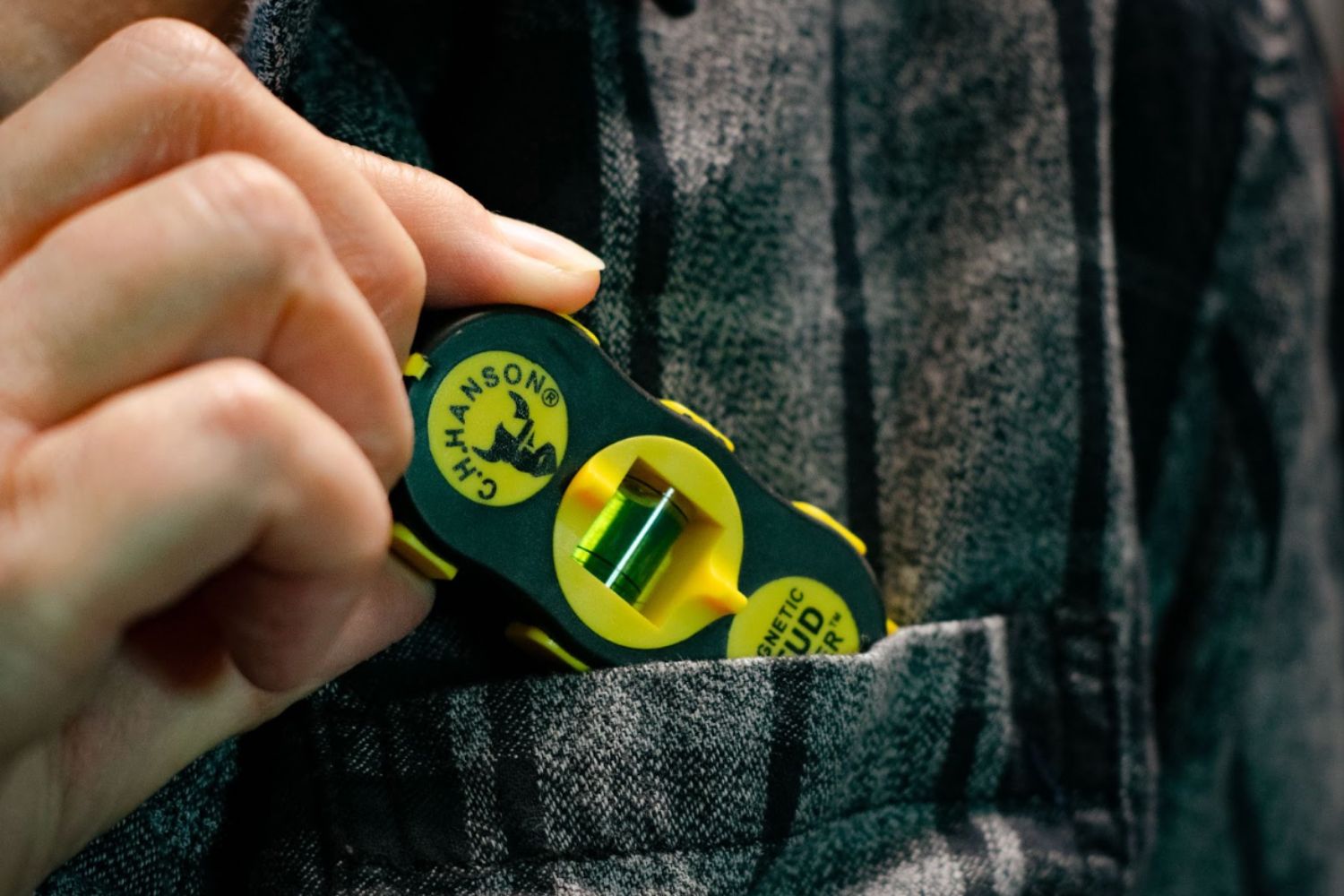
What to Consider When Choosing a Stud Finder
Stud finders fall into two basic categories based on the method they use for stud detection: magnetic or electronic. One’s not inherently better than the other; instead, each one offers different benefits for different situations.
Magnetic Stud Finders
Home builder Mazzuca says magnetic stud finders are “very simple” and use a magnet to detect metal nails or screws in the studs. “These are great for everyday DIY-type work.”
As the user slides the stud finder over a wall, it is magnetically attracted to any spot directly above a nail or screw. The user will feel it pulling in that direction, and may even see the stud finder stick! (Most magnetic stud finders are lightweight and have magnets powerful enough that they will hold through the drywall.)
Magnetic stud finders work to a depth of about ¾ inch, which is sufficient most of the time for finding studs in walls behind standard ½-inch or ⅝-inch drywall. When locating a nail or screw, the likelihood is that there’s also a stud. Because drywall fasteners are located typically 12 to 16 inches apart, it’s recommended that users move a magnet-based stud finder over the wall in a sweeping “S” motion to more quickly detect one.
PROS
- Magnetic stud finders are very affordable
- They act as a wood stud finder (by locating their metal fasteners)
- They do not need batteries to work
- They are often small, which makes them easy to carry in a shirt pocket
CONS
- Because they detect metal instead of the stud itself, they can pick up any metal in the wall—e.g., a metal lathe used to secure plaster or a nail in a horizontal cross-board instead of a vertical stud—making false positives possible
Electronic Stud Finders
Though the technology may sound complicated, electronic stud finders are easy to use: Simply place the tool flat against the wall and move it slowly in a horizontal fashion. When it detects a stud, it will emit an audible alarm and produce a visual indicator, depending on the specific model.
Mazzuca says that electronic stud finders “are more accurate and sense changes in wall density. They can detect pipes and wiring, do deep scans, and have auto-calibration. If you’re doing more than just hanging a picture, an electronic stud finder is what you want.” However, note that a few of these options need to be calibrated to ensure precise results.
PROS
- Electronic stud finders are more precise at locating studs than magnetic ones; they feature either an LED screen or indicator lights that can pinpoint the edges of a stud and the exact center
- High-quality electronic stud detectors can detect studs located deeper in the wall than what a magnet can detect (up to 1½ inches)
CONS
- Electronic stud finders typically cost more than magnetic stud finders
- They require batteries; if the battery runs out and there aren’t extras nearby, it could become a nonfunctioning tool when it’s needed next
Number of Sensors
Like all technology, electronic stud finders have seen many improvements from the time they appeared on the construction market in the 1990s. To pinpoint the location of a stud, an electronic stud finder uses sensors that detect a mass behind the wall. They may come with a single sensor, in which case they will detect only the edge of a stud, or they may come with multiple sensors, giving them the ability to detect both edges as well as the center of the stud. Both single-sensor and multiple-sensor stud finders perform well on average.
Sensor Size
Sensors range in size. Stud finders with larger sensors have a few advantages, such as being able to cover a more expansive area and (sometimes) being able to penetrate thicker or more solid walls, such as plaster or concrete. Smaller sensors, on the other hand, can be highly accurate. For most home DIYers, sensor size is not an issue since a typical stud finder with smaller or larger sensors will be able to pinpoint studs behind drywall.
Additional Features
Today’s stud finders can also pack an extra punch: Many are outfitted with features that extend the usefulness of the stud finder and make it handier. From this list, identify the features that could be the most helpful before settling on a stud finder that works.
- A built-in bubble level, available on either magnetic or electronic stud finders, can assist in leveling shelves or whatever else needs to be attached to the wall. Small bubble levels tend to be less accurate than longer carpenter-type levels because they only record level over a very short distance.
- A built-in laser (electronic models only) is a step up from a bubble level. At the press of a button, shine a laser in a straight line from the stud that’s been located, either vertically or horizontally to help align additional fasteners. The best laser levels make it a snap to hang multiple photos or paintings on a wall—all at the same height.
- Depth adjustment (electronic models only) allows users to switch from detecting studs ¾ inch deep behind drywall to locating any number of objects up to 1½ inches beneath the surface. The ability to inspect further behind the surface is handy for detecting floor joists beneath additional surface coverings like wood, tile, or carpet, but it’s not practical to run an electronic stud finder at this level all of the time. Increasing the depth adjustment takes more energy and runs the batteries down more quickly. Switching back and forth and primarily keeping it on stud-finding mode helps conserve battery life.
- Multipurpose electronic stud finders are designed to detect additional materials within the walls, such as live electrical wires and plastic pipes so users don’t nail or cut into something that might be problematic.
- A “center punch” feature (electronic models only) makes a small hole in the wall right over the center of a stud, which is the optimal spot for inserting a nail or screw—no need to carry a pencil to mark it.
- Varying visual displays (electronic models only) give users some choice in how to “see” the stud. Some electronic stud finders provide a preview of a digital map of the stud beneath the wall on an LED screen; others feature LED lights across the top that blink when the finder is passed over a stud—both provide a reliable way to pinpoint a stud.
- A battery indicator (electronic models only) will alert when it’s time to replace the batteries. While some electronic models take AA or AAA alkaline batteries, a growing number require the use of a small 9-volt battery to adequately power multiple options.
- An ergonomic hand grip makes holding and moving the stud finder easier and is available on both magnetic and electronic models. Some stud finders require depressing a button before scanning the wall for studs. When choosing one of these models, look for a button that’s located in a comfortable spot to both press the button and control the movement of the tool.
FAQs
Not everyone can reliably rap on the wall and find a stud—most can’t—so using a stud finder makes projects go more quickly. Those who are new to the world of electronic and magnetic stud finders are in for a treat. Consider a few questions before picking one out.
Electronic stud finders can often detect a stud through ceramic tiles, especially if the tool comes with deep mode. One of the best options for detecting through most materials is the Franklin Prosensor.
Standard wall framing is 16 inches apart, on-center (OC), meaning the center of one stud will be exactly 16 inches from the center of the next. Alternate spacing is 19.2 inches and 24 inches apart, OC.
That depends on the individual tool. Some beep when they detect the edge of a stud, while others beep when they detect the center of a stud. Some stud finders beep to let the user know they’ve just recalibrated.
Most, but not all. Some outlets come with boxes that are designed to fit in a hole cut through the drywall. A stud finder that detects both studs and live wires can tell the user if this type of outlet box is in use.
